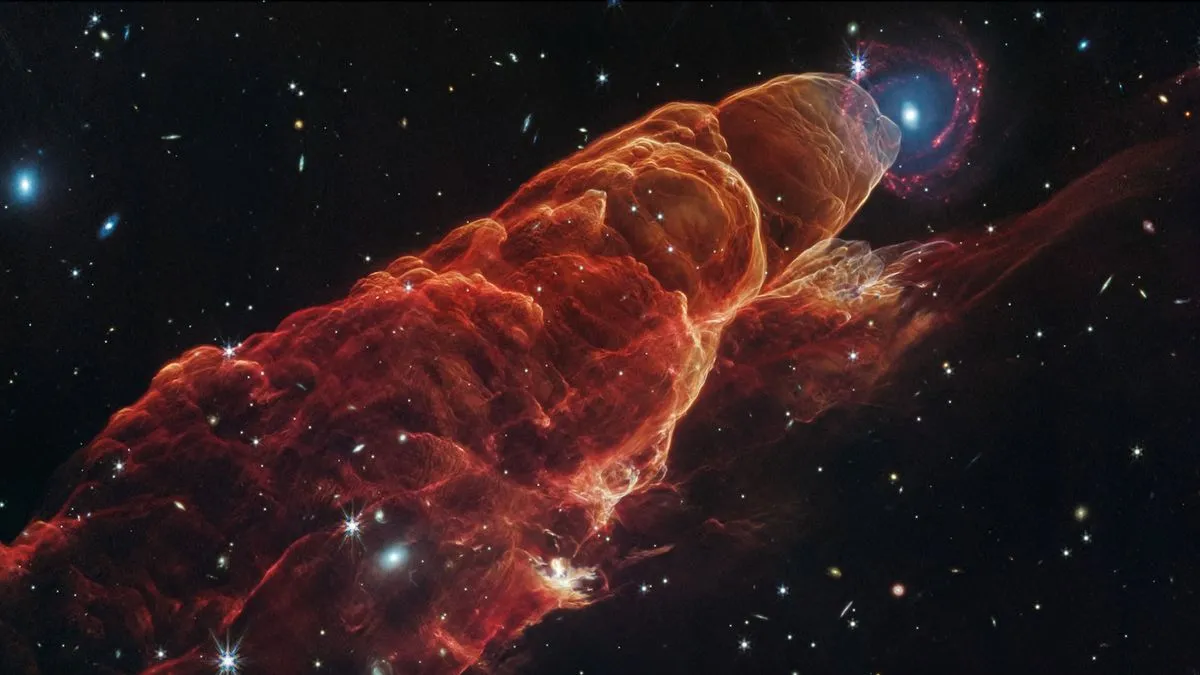
A remarkable cosmic event has led to one of the most breathtaking images ever captured by NASA's James Webb Space Telescope (JWST). The dramatic outflow from a newborn star, identified as Herbig-Haro 49/50 (HH 49/50), fortuitously aligned with a distant spiral galaxy, resulting in a mesmerizing celestial scene that has captivated astronomers and space enthusiasts alike.
Herbig-Haro objects are luminous clouds of gas and dust that form as a result of the intense activity surrounding newborn stars or protostars. These stunning formations occur when jets of charged particles, expelled from young stars at incredibly high velocities, collide with nearby material. This explosive interaction creates brilliant and constantly evolving patterns in the night sky, providing a glimpse into the processes that govern star formation.
Located within the Chamaeleon I Cloud complex — one of the closest stellar nurseries to Earth — Herbig-Haro 49/50 offers an incredible view into the chaotic beauty of star formation. This expansive cloud, rich in gas and dust, is teeming with newborn, sun-like stars, likely resembling the conditions that gave rise to our own solar system.
First observed in 2006 by NASA's now-retired Spitzer Space Telescope, previous studies revealed that the HH 49/50 outflow is racing away from Earth at astonishing speeds ranging from 100 to 300 kilometers per second (60 to 190 miles per second). Scientists have posited that the source of the Herbig-Haro 49/50 outflow is a protostar known as Cederblad 110 IRS4 (CED 110 IRS4), located approximately 1.5 light-years away from the object. In cosmic terms, CED 110 IRS4 is quite young, estimated to be just tens of thousands to a million years old, and is actively growing by drawing in material from its surrounding disk.
As part of its growth process, some of the gas surrounding CED 110 IRS4 is funneled along the protostar's magnetic field lines and ejected as high-speed jets. When these jets collide with surrounding clouds of gas and dust, they create Herbig-Haro objects, which are essentially glowing shock waves marking the area where the outflow interacts with its environment. HH 49/50 is one such impact site and has been affectionately nicknamed the "Cosmic Tornado" due to its striking, swirling shape.
While Spitzer's images provided an initial glimpse, they lacked the clarity necessary to identify the fuzzy object located at the tip of HH 49/50. Thanks to JWST's advanced capabilities, astronomers have now captured images that reveal glowing hydrogen and carbon monoxide molecules, depicted in orange and red, which are being energized by the powerful jets from the nearby newborn star. These illuminated molecules, along with energized dust grains, showcase the intricate and dynamic processes that shape the star's environment.
Webb's detailed images of HH 49/50 reveal arcs of glowing gas that have allowed astronomers to trace the jet back to its source — CED 110 IRS4. Interestingly, not all arcs align in the same direction. One particularly unusual feature, an outcrop near the top of the main outflow, does not seem to conform to the rest of the structure. Scientists speculate that it may represent a second, unrelated outflow that just happens to overlap in the image. Another possibility is that the main outflow is undergoing fragmentation, resulting in this peculiar shape. The irregular patterns could also be attributed to the slow, wobbly motion of the protostar's jet over time — a phenomenon known as precession.
The captivating image captured by the James Webb Space Telescope not only enhances our understanding of Herbig-Haro 49/50 but also underscores the telescope's role in advancing our knowledge of the universe and the intricacies of star formation.